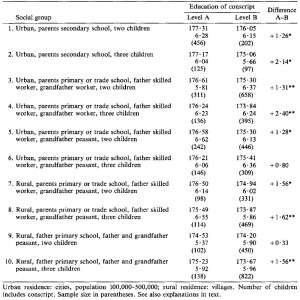A study titled “Stature, upward social mobility and the nature of statural differences between social classes” by T. Bielicki and H. Waliszko shows yet again that there exists a positive correlation between height and education.
This article is a follow up to a previous article I wrote which was based on the study “Body height and upward social mobility” by T. Bielicki and J. Charzewski. The findings of that study reached the same conclusion that there exists a positive correlation between height and education. For ease of reading I have broken down the current study into sections as outlined below.
The Hypothesis
“In modern industrial societies tall individuals are for some reason more likely to advance , or less likely to regress, in socio-economic status during their lifetime than are short individuals. Advancement or regression being measured with reference to an ‘initial condition’ such as parental socio-economic status”
Study Parameters
- Total of 26,000 individuals examined.
- 10 groups of 19-year-old Polish military conscripts born in 1967 (examined in 1986).
- Each group (out of the 10 chosen) was different (non-overlapping) and homogeneous with regard to four criteria:
- Parental education.
- Parental (plus, for some groups, paternal grandfather’s) occupation.
- Urban-rural residence.
- Number of siblings.
- Urban residence: city (population 100,000 – 500,000) ; rural: village.
- Study looked at two levels of education: secondary schooling including college (Level A) and basic trade school (level B).
- Basic trade school in Poland is 2 or 3 years above primary schooling in a specialised vocation (e.g. electrician or mechanic).
Results
Within each one of the 10 groups considered the 19-year-olds who have gone to secondary school are on average taller than their age-mates who come from a very similar social background but who never moved beyond the level of basic schooling. Out of the 10 groups, as many as 8 show a statistically significant group of subjects of Level A compared to Level B.
The table below shows the height (mean and standard deviation) for subjects from each of the 10 groups. Number of subjects in each group is given in parenthesis underneath the standard deviation. Click on the image to enlarge.
Hypothetical Explanations
The interpretation of the results is by no means straightforward so the authors provided three possible hypothetical explanations:
Explanation I
Tallness is genetically linked with some attributes of the intellect or personality which facilitate educational achievement or enhance motivation for such achievement. This is classed as an ad hoc explanation and seems unlikely.
Explanation II
Tallness is a trait which in many social situations is an asset and may help to open the gates to social acceptance. This seems plausible however it is not readily apparent how it could be used as an explanation of the specific results reported in the study. A decision on which type of schooling to pursue beyond primary school is decided at age 12-14 years when physical growth is far from complete.
Explanation III
The correlation is brought about by an underlying ‘third factor’ (consistent with the previous study) of a purely environmental nature.
It can be best described as a sequence of ’cause and effect’ events:
Lower living standards → slower maturation of child → less matured child does worse in primary school compared to more matured children → poor school performance discourages them from going to secondary school. Being a slow developer, the child has not yet completed his growth by the age of 19 years and therefore tends to be shorter. This explanation seems to be the most likely reasoning for the results above.
Conclusion
The findings from this study are without a doubt very intriguing and support the notion that being tall is a blessing and comes with a host of advantages, some of which may even influence your life without you ever realising! Whilst there are always exceptions to any general rule the results above suggest that the children that end up as tall adults are more likely to thrive and provide a higher standard of living for their families which in turn means their children will grow taller and continue the cycle.
What are your thoughts about this study? I’d love to hear from you in the comments below.
Stand tall and be proud.
- Image credit for education mortarboard (cover image): here
- The study article can be found in: The Annals of Human Biology (1992), vol. 19, no. 6, 589-593.


